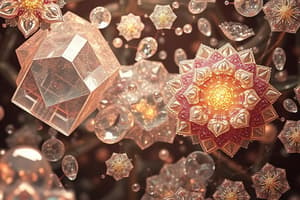Podcast
Questions and Answers
Which type of solid is characterized by high melting points, hardness, and acts as an insulator in solid state, but conducts electricity in molten state?
Which type of solid is characterized by high melting points, hardness, and acts as an insulator in solid state, but conducts electricity in molten state?
- Ionic solid (correct)
- Covalent solid
- Metallic solid
- Molecular solid
How does the presence of Schottky defects generally affect the density of a crystalline solid?
How does the presence of Schottky defects generally affect the density of a crystalline solid?
- Increases the density
- Decreases the density (correct)
- Does not affect the density
- Density fluctuates depending on temperature
Which of the following statements accurately describes the difference between crystalline and amorphous solids?
Which of the following statements accurately describes the difference between crystalline and amorphous solids?
- Crystalline solids are always isotropic, while amorphous solids are anisotropic.
- Crystalline solids melt over a range of temperatures, while amorphous solids have a sharp melting point.
- Crystalline solids have a definite geometric shape, while amorphous solids lack long-range order. (correct)
- Crystalline solids have a short-range order, while amorphous solids have a long-range order.
In a face-centered cubic (FCC) unit cell, what is the number of atoms that are actually present inside the unit cell?
In a face-centered cubic (FCC) unit cell, what is the number of atoms that are actually present inside the unit cell?
What type of point defect arises when an ion leaves its normal site and occupies an interstitial site in the crystal lattice?
What type of point defect arises when an ion leaves its normal site and occupies an interstitial site in the crystal lattice?
Which of the following factors primarily determines the type of crystal lattice formed by a metallic solid?
Which of the following factors primarily determines the type of crystal lattice formed by a metallic solid?
How does increasing temperature affect the number of vacancy defects in a metal crystal?
How does increasing temperature affect the number of vacancy defects in a metal crystal?
What is the coordination number of each ion in a cesium chloride (CsCl) crystal structure?
What is the coordination number of each ion in a cesium chloride (CsCl) crystal structure?
Given a solid with the formula $A_2B$, where A occupies tetrahedral voids in a face-centered cubic lattice formed by B ions, what fraction of the tetrahedral voids are occupied?
Given a solid with the formula $A_2B$, where A occupies tetrahedral voids in a face-centered cubic lattice formed by B ions, what fraction of the tetrahedral voids are occupied?
Which of the following solids is most likely to exhibit anisotropy?
Which of the following solids is most likely to exhibit anisotropy?
A metal crystallizes in a face-centered cubic structure with a unit cell edge length of 400 pm. If the atomic radius of the metal is $r$, what is the relationship between $r$ and the edge length $a$?
A metal crystallizes in a face-centered cubic structure with a unit cell edge length of 400 pm. If the atomic radius of the metal is $r$, what is the relationship between $r$ and the edge length $a$?
In a compound, oxide ions are arranged in a cubic close-packed lattice, and cations occupy one-eighth of the tetrahedral voids. What is the chemical formula of the compound?
In a compound, oxide ions are arranged in a cubic close-packed lattice, and cations occupy one-eighth of the tetrahedral voids. What is the chemical formula of the compound?
Which of the following statements correctly describes the effect of Frenkel defects on the electrical conductivity of an ionic solid?
Which of the following statements correctly describes the effect of Frenkel defects on the electrical conductivity of an ionic solid?
How does the contribution of an atom located at the edge of a unit cell differ from an atom located at the body center of the unit cell, in terms of their contribution to the number of atoms per unit cell?
How does the contribution of an atom located at the edge of a unit cell differ from an atom located at the body center of the unit cell, in terms of their contribution to the number of atoms per unit cell?
What is the primary reason why amorphous solids do not have a sharp melting point, unlike crystalline solids?
What is the primary reason why amorphous solids do not have a sharp melting point, unlike crystalline solids?
If a certain metal forms an oxide with the formula $M_2O_3$ and the metal ions occupy 2/3 of the octahedral voids in a cubic close-packed array of oxide ions, what does this indicate about the valency of the metal?
If a certain metal forms an oxide with the formula $M_2O_3$ and the metal ions occupy 2/3 of the octahedral voids in a cubic close-packed array of oxide ions, what does this indicate about the valency of the metal?
How would you expect the density of a solid to change if it exhibits Schottky defects, and how is this different from solids exhibiting Frenkel defects?
How would you expect the density of a solid to change if it exhibits Schottky defects, and how is this different from solids exhibiting Frenkel defects?
Consider a solid made up of two elements, A and B, where B atoms are arranged in a cubic close-packed (ccp) structure, and A atoms occupy all the tetrahedral sites. What is the formula of the compound formed?
Consider a solid made up of two elements, A and B, where B atoms are arranged in a cubic close-packed (ccp) structure, and A atoms occupy all the tetrahedral sites. What is the formula of the compound formed?
Which type of solid is most likely to be hard, have a high melting point, and be a poor conductor of electricity?
Which type of solid is most likely to be hard, have a high melting point, and be a poor conductor of electricity?
A certain crystalline solid has a structure where X atoms are at the corners of the cube and Y atoms are at the center of each face. What is the formula of this compound?
A certain crystalline solid has a structure where X atoms are at the corners of the cube and Y atoms are at the center of each face. What is the formula of this compound?
Flashcards
Solid States
Solid States
Solid states is a part of the class 12th chemistry syllabus for MHTCET 2025.
MHTCET
MHTCET
MHTCET is a competitive exam for admission to engineering and pharmacy courses in Maharashtra.
Batch
Batch
A batch is a group of students preparing together for an exam.
PYQ
PYQ
Signup and view all the flashcards
Test Series
Test Series
Signup and view all the flashcards
Study Notes
- Solid states Part 1 for MHTCET 2025 is discussed in this session
- The session is part of the Beta 4.0 batch
- The lecture is for the 12th class chemistry syllabus
- GanitAnk provides the Beta 4.0 batch for MHTCET 2025
Solid State Topics
- Introduction to solid states and their general characteristics
- Types of solid states: amorphous and crystalline solids
- Examples of amorphous solids include rubber and plastic
- Crystalline solids possess long-range order, while amorphous solids have short-range order
- Isotropic properties are the same in all directions, while anisotropic properties differ based on direction
- Amorphous solids are generally isotropic
- Crystalline solids are anisotropic due to the arrangement of particles
- Crystalline solids have a sharp melting point, whereas amorphous solids melt over a range of temperatures
- Classification of crystalline solids is based on the nature of constituent particles and bonding
Types of Crystalline Solids
-
Molecular solids consist of molecules as their constituent particles
-
Molecular solids are further divided into polar, nonpolar, and hydrogen-bonded types
-
Nonpolar molecular solids: held by weak dispersion forces or London forces, have low melting points, and are soft and non-conductors of electricity (e.g., Ar, CCl4, H2, I2).
-
Polar molecular solids: Held together by relatively stronger dipole-dipole interactions, have higher melting points than nonpolar solids but are still soft and non-conductors (e.g., HCl, SO2).
-
Hydrogen-bonded molecular solids: Strong hydrogen bonding, examples include ice which is a non-conductor
-
Ionic solids consist of ions as their constituent particles
-
Characterized by strong electrostatic forces, high melting points, hardness, and non-conduction of electricity in the solid-state, but they conduct when dissolved in water or melted (e.g., NaCl, MgO, ZnS, CaF2).
-
Metallic solids consist of metal atoms
-
Characterized by metallic bonding, hardness, and conductivity of electricity (e.g., Na, Cu, Ag, Fe).
-
Covalent network solids consist of nonmetal atoms
-
Characterized by covalent bonding, hardness, very high melting points, and they may or may not conduct electricity (e.g., SiO2, diamond, SiC, AlN).
Crystal Structures
- Lattice points represent the positions of constituent particles (atoms, ions, or molecules) in a crystal lattice
- A unit cell is the smallest repeating unit in a crystal lattice that, when repeated in three dimensions, forms the entire lattice
- Primitive unit cells contain lattice points only at the corners
- Centered unit cells have additional lattice points either on faces or within the body
- Seven primitive unit cells exist, which when combined with centered unit cells give rise to 14 Bravais lattices
Types of Unit Cells
- Simple/Primitive Cubic Unit Cell: Particles are only at the corners of the cube
- Body-Centered Cubic (BCC) Unit Cell: Particles are at the corners and one in the center of the cube
- Face-Centered Cubic (FCC) Unit Cell: Particles are at the corners and one at each face of the cube
Parameters of a Unit Cell
- Defined by edge lengths (a, b, c) and angles between the edges (α, β, γ)
- a, b, and c are the dimensions along the x, y, and z axes
- α is the angle between edges b and c
- β is the angle between edges a and c
- γ is the angle between edges a and b
Contribution of Particles in a Unit Cell
- Corner: Each corner particle contributes 1/8 to the unit cell
- Face Center: Each face-centered particle contributes 1/2 to the unit cell
- Body Center: A body-centered particle contributes fully (1) to the unit cell
- Edge Center: Each edge-centered particle contributes 1/4 to the unit cell
Number of Atoms per Unit Cell
- Simple Cubic: 1/8 contribution from each of the 8 corners, totaling 1 atom per unit cell
- BCC: 1/8 contribution from each of the 8 corners plus 1 full atom at the body center, totaling 2 atoms per unit cell
- FCC: 1/8 contribution from each of the 8 corners plus 1/2 contribution from each of the 6 faces, totaling 4 atoms per unit cell
Studying That Suits You
Use AI to generate personalized quizzes and flashcards to suit your learning preferences.




